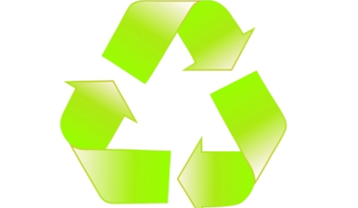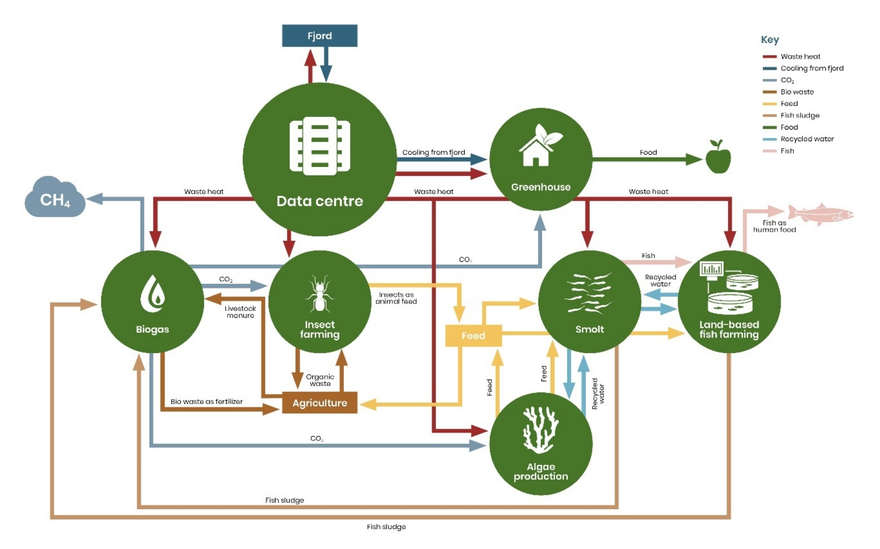Data centers are the backbone of the digital society and they’re only going to become more important. Nevertheless, they consume (and waste) a huge amount of energy.
Step one is, of course, to make sure data centers run on renewable power and optimize energy use.
But what is step two? In Green Mountain we have a vision. A vision of data centers becoming a true contributor to the circular economy. The next solution is to ensure that waste heat from data centers is used for climate-positive business development.
A sustainable symbiosis
This is the idea: Based on the large amounts of waste heat data centers generate, we can create a symbiosis between different industries, where they use each other’s ‘residual waste’. The aim is to reduce and eventually eliminate the CO2 emissions to the benefit of businesses, society, and the environment.
This can be done in several ways and at different scales dependent on given local factors. But let us present an example that was created by five Norwegian master students on behalf of the local energy company Lyse. The five students looked at an area in a traditional agricultural district outside Stavanger on the west-coast of Norway, zoned for energy-intensive industry.
The students first looked at 31 different industries, and by using an elimination method based on different evaluation criteria*, they finally ended up with five different industries that ought to fit together perfectly. These identified industries include biogas plants, fish farming on land, insect farming, algae production, and greenhouses.
The data center is the key
It all starts with the data center that produces residual heat that the other industries can use.
In addition, the five industries can use each other’s input and output in their production cycles. For instance, the biogas plant can use livestock manure from agriculture, and fish sludge from land-based fish farming to produce biogas.
The biogas can, in return, be used in greenhouses, for insect farming or algae production. The latter two are more sustainable alternatives of animal feed for land-based fish-farming, by eliminating the need for long-distance transport of imported soy. In other words, it all fits together in a more sustainable cycle. These are just a few examples of how the symbiosis can work.
The sketch below illustrates the idea in more detail:
The greater good
Establishing a cluster like this benefits both the environment, the community and the bottom-line of the participating organizations. In the students’ medium-scale example, they calculated that the CO2 reductions alone corresponded to approx. the annual emissions of 2.5 million cars.
In addition, hundreds of new jobs would be created as well as indirect jobs and positive ripple effects for the local business community. It is really about shifting the whole mindset when establishing new industries. Instead of looking solely om your own business you must look at how collaboration with other businesses can create a greater good.
The example in this article is adapted to the local conditions, but the idea can be transferred to anywhere. For instance, at Green Mountain’s data center at Rennesøy, Norway the world’s first land-based lobster farm will use the waste heat to grow lobsters more sustainably. Not only will we make use of the residual heat, but the lobster company will also save 30 percent in operational costs.
In other words, there are endless opportunities if we, as an industry, dare to think bigger and bolder about data centers’ place in the circular economy.
*Evaluation criteria:
- Technology Readiness Level
- Contribution to symbiosis
- UN sustainability goals
- Economic factors
- Ripple effects in the community
More...
-
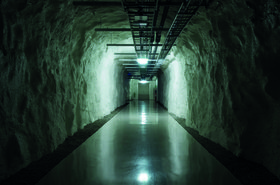
Azrieli Group acquires Green Mountain for $850 million
Israel real estate firm buys Norwegian company, having previously acquired 20 percent stake in Compass
-
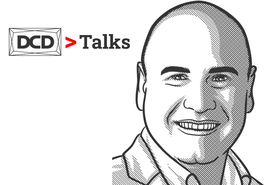
DCD>Talks Norway with Tor Kristian Gyland
Tor Kristian Gyland, Chief Executive Officer, Green Mountain chats exclusively with George Rockett from DCD, in partnership with Vertiv.
-
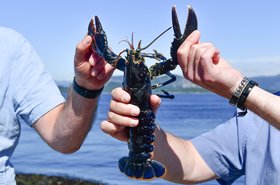
Crustacean cultivation: Lobsters and data centers
A land-based farm has finally produced plate-sized lobsters- thanks to a data center


